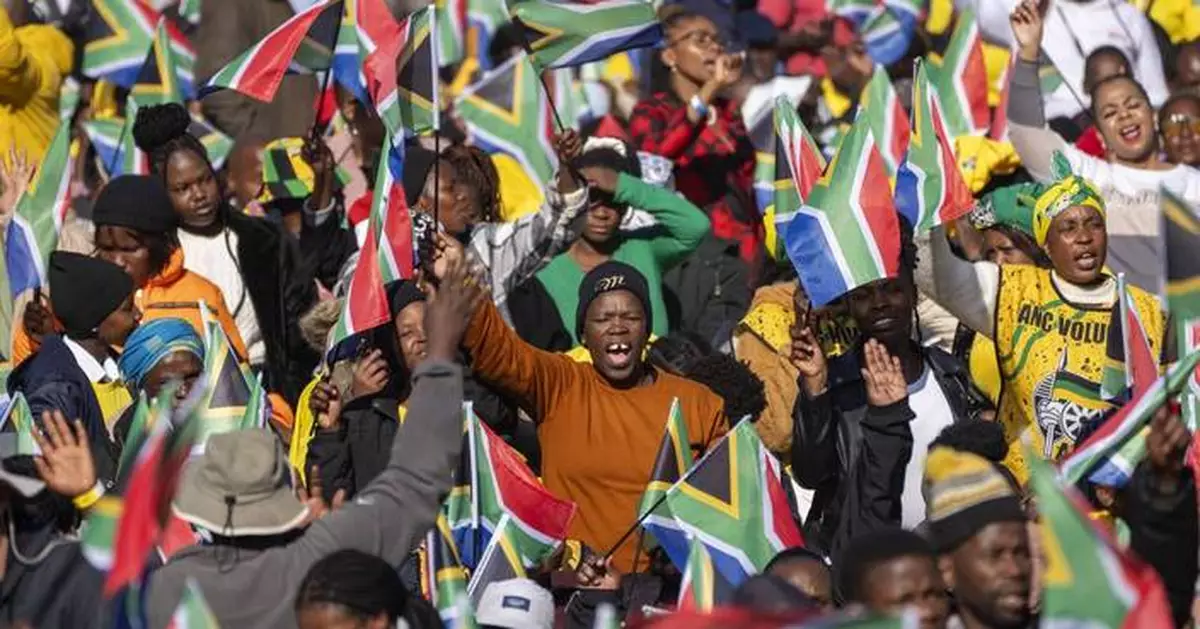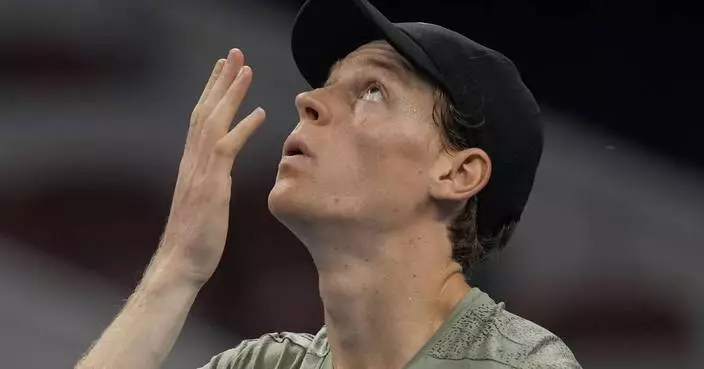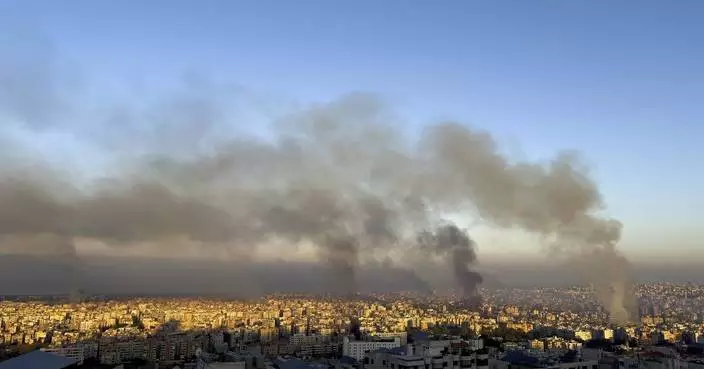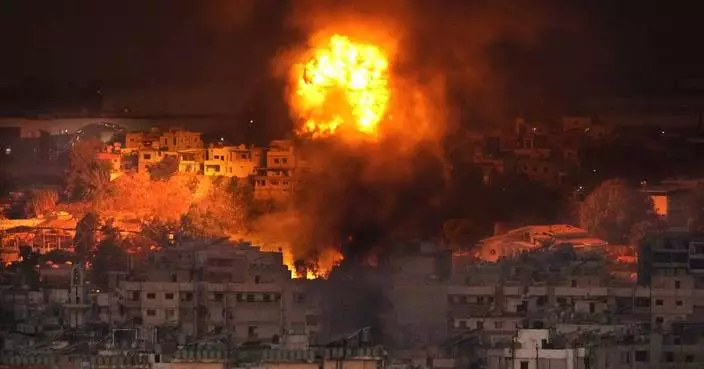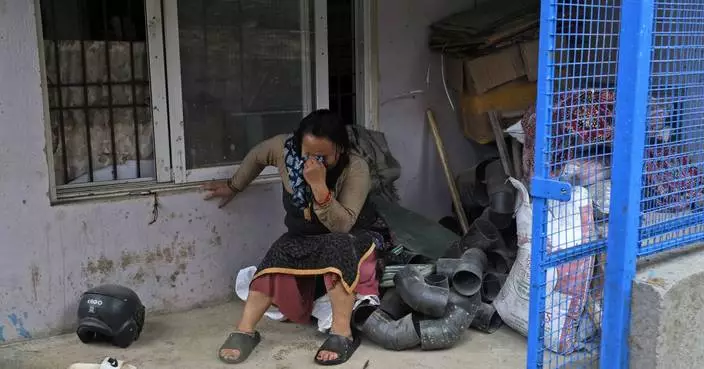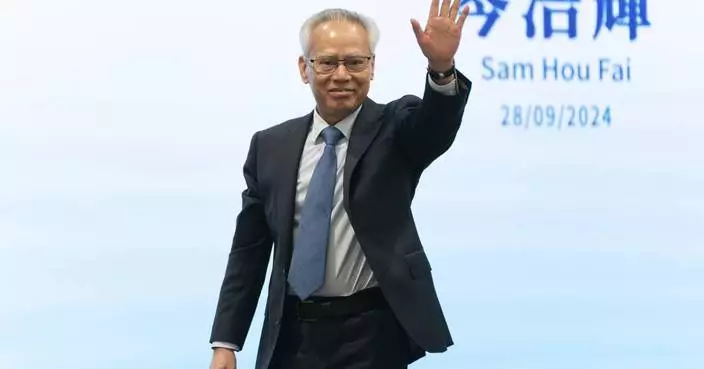CAPE TOWN, South Africa (AP) — In a country where racial segregation was once brutally enforced, South Africa's new coalition government has brought a Black president and a white opposition leader together in an image of unity.
Yet the power-sharing agreement sealed a week ago between President Cyril Ramaphosa's African National Congress party and the Democratic Alliance, one of South Africa's few white-led parties, has unwittingly renewed some racial rifts.
Click to Gallery
In this photo provided by the South African Government Communication and Information System, (GCIS), South African Président Cyril Ramaphosa, right, greets opposition Democratic Alliance (DA) leader, John Steenhuisen, left, at the first sitting of Parliament since elections, in Cape Town, South Africa, Friday, June 14, 2024. In a country where racial segregation was once brutally enforced, South Africa's new coalition government has brought a Black president and a white opposition leader together in what is on the face of it a picture of unity. (South African GCIS via AP)
CAPE TOWN, South Africa (AP) — In a country where racial segregation was once brutally enforced, South Africa's new coalition government has brought a Black president and a white opposition leader together in an image of unity.
FILE - Supporters of the main opposition Democratic Alliance (DA) party attend a final election rally, in Benoni, South Africa, on May 26, 2024. In a country where racial segregation was once brutally enforced, South Africa's new coalition government has brought a Black president and a white opposition leader together in what is on the face of it a picture of unity. (AP Photo/Themba Hadebe, File)
FILE - Leader of the main opposition Democratic Alliance John Steenhuisen, right, shakes hands with ANC's Chairman Gwede Mantashe, left, after elections on a visit to the Results Operation Centre (ROC) in Midrand, Johannesburg, South Africa, on May 31, 2024. (AP Photo/Themba Hadebe, File)
FILE - South Africans cheer ahead of the inauguration of South Africa's Cyril Ramaphosa as President at the Union Buildings South Lawns in Pretoria, South Africa, on June 19, 2024. In a country where racial segregation was once brutally enforced, South Africa's new coalition government has brought a Black president and a white opposition leader together in what is on the face of it a picture of unity. (AP Photo/Jerome Delay, File)
In this photo provided by the South African Government Communication and Information System, (GCIS), South African Président Cyril Ramaphosa, right, greets opposition Democratic Alliance (DA) leader, John Steenhuisen, left, at the first sitting of Parliament since elections, in Cape Town, South Africa, Friday, June 14, 2024. In a country where racial segregation was once brutally enforced, South Africa's new coalition government has brought a Black president and a white opposition leader together in what is on the face of it a picture of unity. (South African GCIS via AP)
FILE - South Africans gather ahead of the inauguration of South Africa's Cyril Ramaphosa as President at the Union Buildings South Lawns in Pretoria, South Africa, on June 19, 2024. In a country where racial segregation was once brutally enforced, South Africa's new coalition government has brought a Black president and a white opposition leader together in what is on the face of it a picture of unity. (AP Photo/Jerome Delay, File)
Many Black South Africans have expressed discomfort with a white-led party being back in power, even in a coalition. The country is haunted by the apartheid system of white minority rule that ended 30 years ago but is still felt by millions among the Black majority who were ruthlessly oppressed by a white government and remain affected by unresolved issues of poverty and inequality.
South Africa is now faced with the likelihood of seeing more white people in senior government positions than ever since apartheid ended. White people make up around 7% of the country’s population of 62 million.
The ANC liberated South Africa from apartheid in 1994 under Nelson Mandela, the country's first Black president. Its three-decade political dominance ended in the landmark May 29 election, forcing it to form a coalition. The DA, with its roots in liberal white parties that stood against apartheid, won the second largest share of votes.
Both have promoted their coming together in a multi-party coalition as a new unity desperately needed in a country with vast socioeconomic problems.
But history lingers. The DA suspended one of its white lawmakers Thursday, days after being sworn into Parliament, over racist slurs he made in a social media video more than a decade ago. Renaldo Gouws — reportedly a student in his 20s at the time — used an especially offensive term for Black people that was infamous during apartheid and is now considered hate speech.
Gouws faces disciplinary action from his party, and the South African Human Rights Commission said it will take him to court. The DA, which previously fended off allegations of favoring whites, is again under scrutiny.
The Congress of South African Trade Unions, an important political ally of the ANC, asserted that Gouws’ outburst was symptomatic of a DA that is “soft on racists.” The DA “needs to reflect on and address this if it wants to be accepted as a partner in the government of national unity by ordinary South Africans,” it said.
DA leader John Steenhuisen denied in a television interview that his party is dedicated only to white interests, saying it wouldn’t have won the second largest share of votes in a Black majority country if it was. The DA has Black and white lawmakers and supporters, but its only Black leader left the party in 2019, questioning its commitment to Black South Africans.
Political analyst Angelo Fick said the DA does have a “sense of whiteness” in the eyes of many South Africans and has created that by being “utterly disinterested in speaking to the concerns about race from Black South Africans.”
Shortly before Gouws' case, racially charged language came from another direction when the MK Party of former President Jacob Zuma — once an ANC leader — called Ramaphosa a “house negro” for entering into the agreement with the DA. Zuma's party also referred to white DA chairperson Helen Zille as Ramaphosa's “slave master.”
The MK Party and the Economic Freedom Fighters — the third and fourth biggest parties in Parliament — have refused to join what the ANC calls a government of national unity open to all. They said the fundamental reason is the DA, which they say is committed only to the well-being of South Africa's white minority.
“We do not agree to this marriage of convenience to consolidate the white monopoly power over the economy,” EFF leader Julius Malema said.
Malema has sometimes provoked racial tensions in demanding change, once saying, “We are not calling for the slaughtering of white people, at least for now,” and that South Africa’s “white man has been too comfortable for too long.”
He now says his party is not against white people but against a perceived “white privilege” that leaves 64% of Black people in poverty compared with 1% of white people, according to a 2021 report by the South African Human Rights Commission.
Malema represents a new opposition to the ANC by many Black South Africans frustrated over the race-based inequality that's evident after 30 years of freedom. White people generally live in posh neighborhoods. Millions of Black people live in impoverished townships on the outskirts.
That frustration led many voters to give up on the ANC. The concerns about teaming up with the DA could weaken the party even further.
In his inauguration speech Wednesday, Ramaphosa recognized the “toxic” divisions that remain decades after Mandela preached racial reconciliation. “Our society remains deeply unequal and highly polarized,” Ramaphosa said.
The ANC is trying to use the coalition as a kind of reboot of Mandela's ideals.
“To us, it doesn’t matter whether the cat is black or white," ANC Secretary-General Fikile Mbalula said of the agreement with the DA. Mandela had used the phrase to signal he was open to all races serving in South Africa's government.
“Fundamentally," Mbalula said, “the question is how do we move the country forward.”
AP Africa news: https://apnews.com/hub/africa
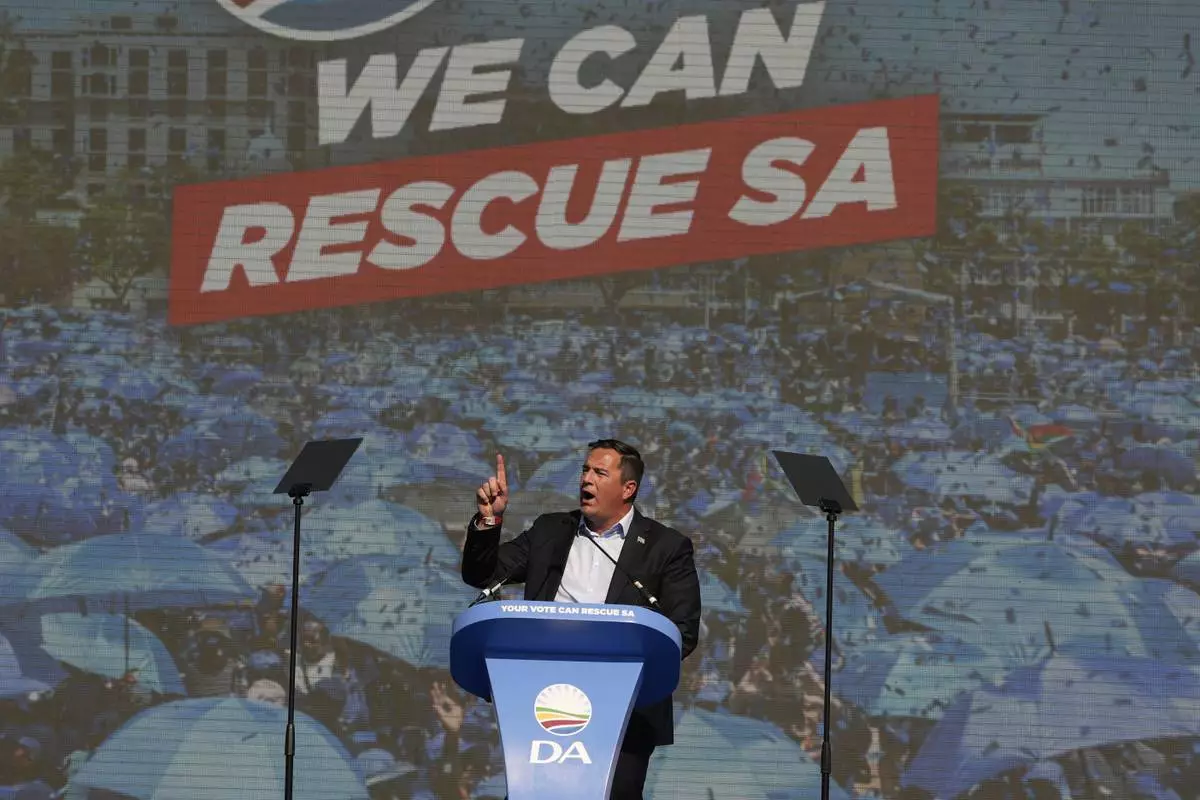
FILE - Main opposition Democratic Alliance (DA) party leader, John Steenhuisen, delivers his speech at a final election rally in Benoni, South Africa, on May 26, 2024. In a country where racial segregation was once brutally enforced, South Africa's new coalition government has brought a Black president and a white opposition leader together in what is on the face of it a picture of unity. (AP Photo/Themba Hadebe, File)
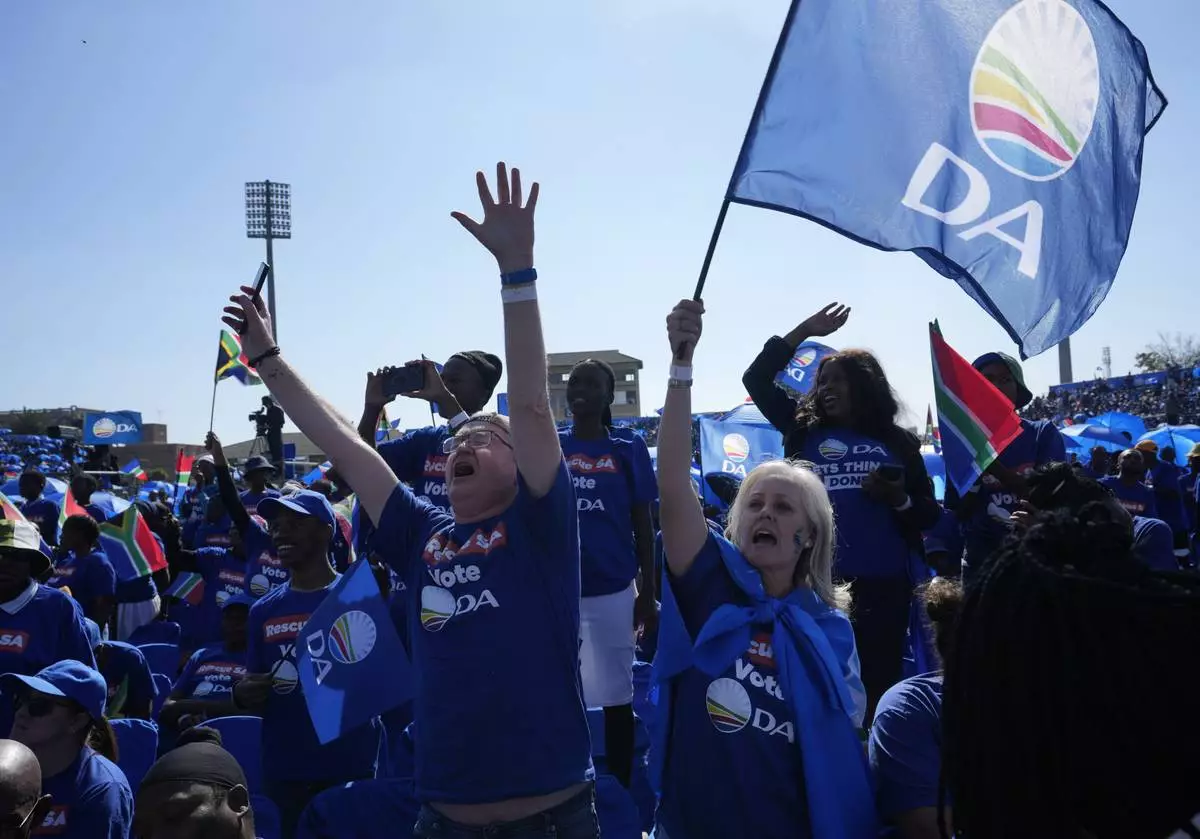
FILE - Supporters of the main opposition Democratic Alliance (DA) party attend a final election rally, in Benoni, South Africa, on May 26, 2024. In a country where racial segregation was once brutally enforced, South Africa's new coalition government has brought a Black president and a white opposition leader together in what is on the face of it a picture of unity. (AP Photo/Themba Hadebe, File)
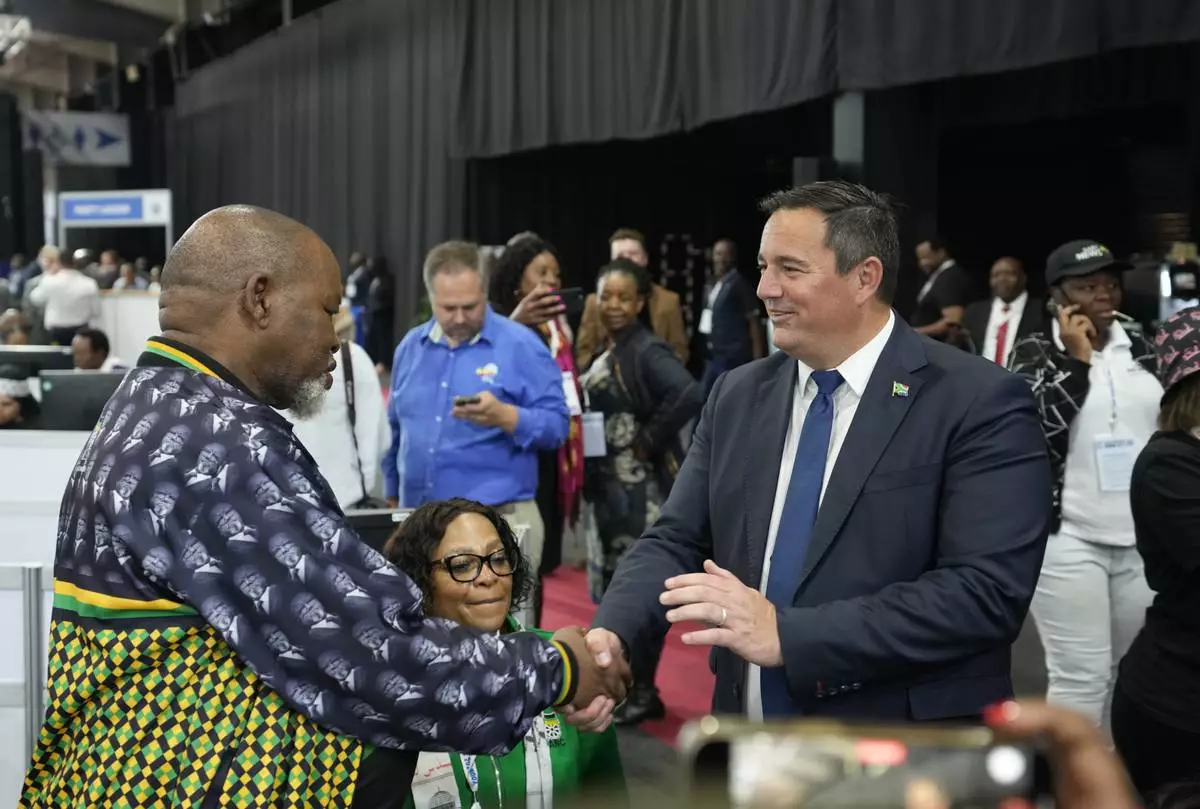
FILE - Leader of the main opposition Democratic Alliance John Steenhuisen, right, shakes hands with ANC's Chairman Gwede Mantashe, left, after elections on a visit to the Results Operation Centre (ROC) in Midrand, Johannesburg, South Africa, on May 31, 2024. (AP Photo/Themba Hadebe, File)
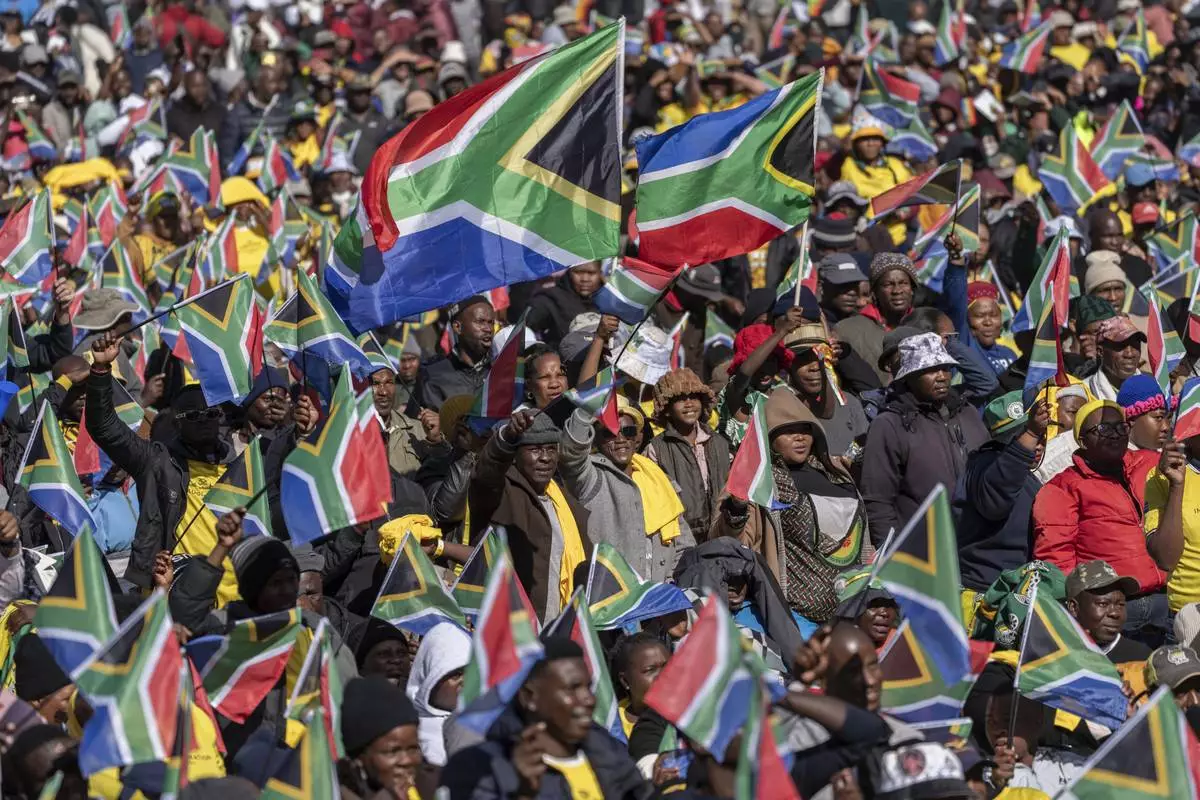
FILE - South Africans cheer ahead of the inauguration of South Africa's Cyril Ramaphosa as President at the Union Buildings South Lawns in Pretoria, South Africa, on June 19, 2024. In a country where racial segregation was once brutally enforced, South Africa's new coalition government has brought a Black president and a white opposition leader together in what is on the face of it a picture of unity. (AP Photo/Jerome Delay, File)
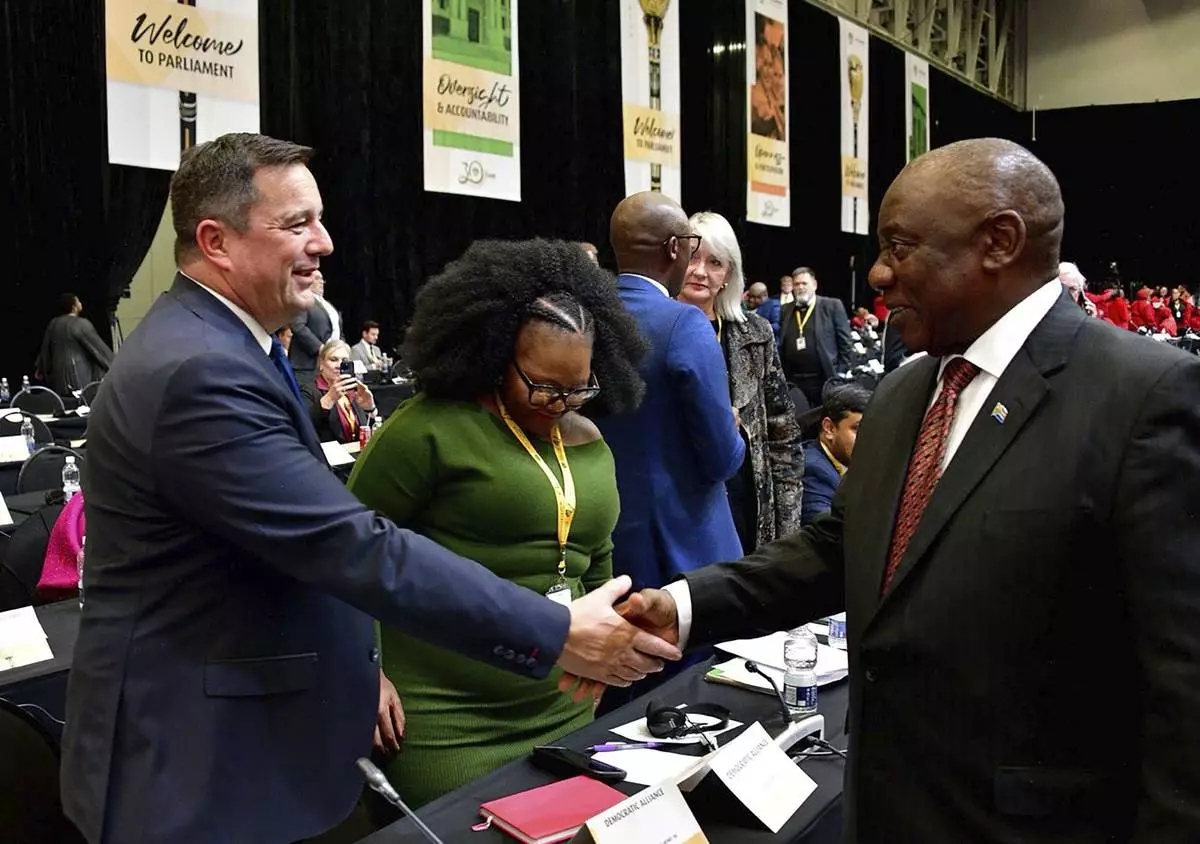
In this photo provided by the South African Government Communication and Information System, (GCIS), South African Président Cyril Ramaphosa, right, greets opposition Democratic Alliance (DA) leader, John Steenhuisen, left, at the first sitting of Parliament since elections, in Cape Town, South Africa, Friday, June 14, 2024. In a country where racial segregation was once brutally enforced, South Africa's new coalition government has brought a Black president and a white opposition leader together in what is on the face of it a picture of unity. (South African GCIS via AP)
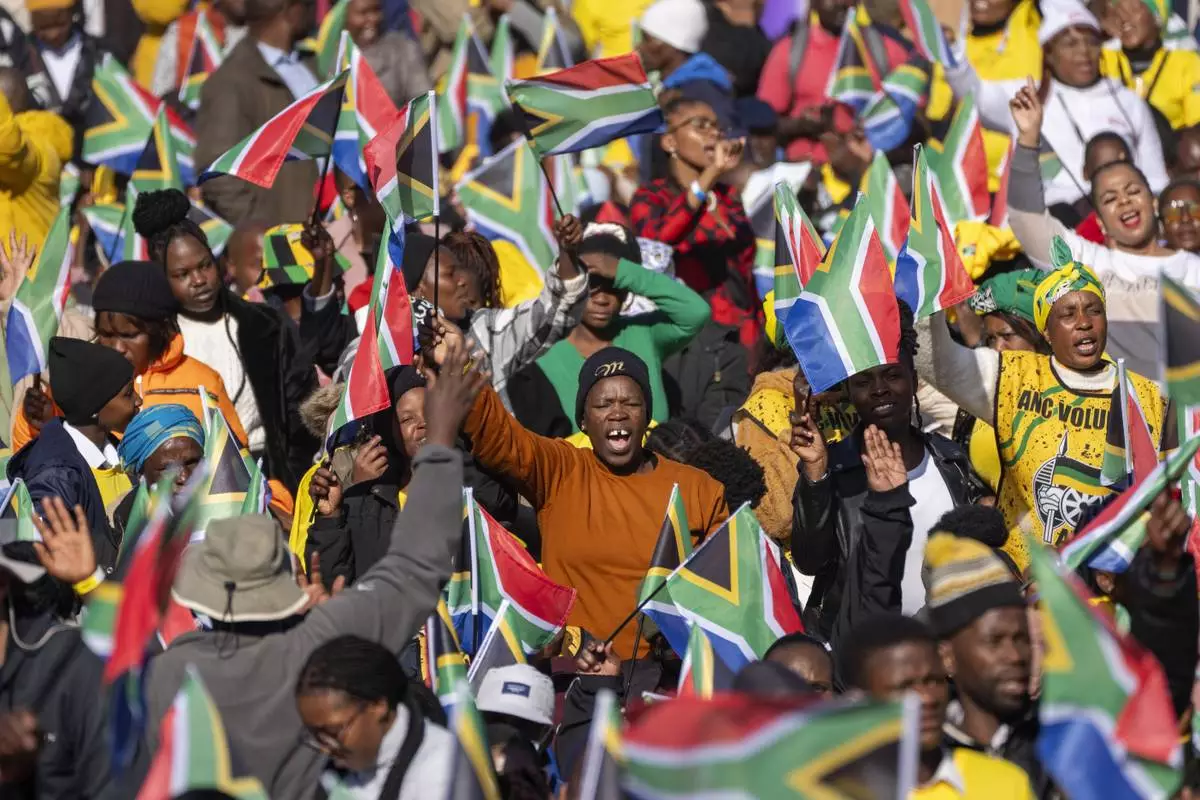
FILE - South Africans gather ahead of the inauguration of South Africa's Cyril Ramaphosa as President at the Union Buildings South Lawns in Pretoria, South Africa, on June 19, 2024. In a country where racial segregation was once brutally enforced, South Africa's new coalition government has brought a Black president and a white opposition leader together in what is on the face of it a picture of unity. (AP Photo/Jerome Delay, File)
TEL AVIV, Israel (AP) — Israel said Saturday that it killed Hezbollah leader Hassan Nasrallah, dealing its most significant blow to the Lebanese militant group after months of fighting. There was no immediate confirmation from Hezbollah.
If the claim is true, Nasrallah is by far the most powerful target to be killed by Israel in weeks of intensified fighting with Hezbollah. The military said it carried out a precise airstrike on Friday while Hezbollah leadership met at their headquarters in Dahiyeh, south of Beirut.
The Lebanese Health Ministry said six people were killed and 91 injured in the Beirut strikes Friday, which leveled six apartment buildings. Ali Karki, the Commander of Hezbollah’s Southern Front, and additional Hezbollah commanders were also killed in the attack, the Israeli military said.
Lt. Col. Nadav Shoshani, an army spokesperson, said the airstrike was based on years of tracking Nasrallah along with “real time information” that made it viable. He said Nasrallah’s death had been confirmed through various types of intelligence, but declined to elaborate.
Shoshani declined to say what munitions were used in the strike or provide an estimate on civilian deaths in the strike, only saying that Israel takes measures to avoid civilians whenever possible and clears strikes ahead of time with intelligence and legal experts.
Israel’s Chief of Staff, Lt. Gen. Herzi Halevi, said Saturday that the elimination of Nasrallah was “not the end of our toolbox,” indicating that more strikes were planned. He said that the strike targeting Hezbollah leadership was the result of a long period of preparation.
It was not immediately clear what effect the strike would have on Hezbollah or fighting between the sides that has dragged on for nearly a year. Israel has vowed to step up pressure on Hezbollah until it halts its attacks that have displaced tens of thousands of Israelis from communities near the Lebanese border. The recent fighting has also displaced more than 200,000 Lebanese in the past week, according to the United Nations.
The military said it was mobilizing additional reserve soldiers as tensions escalate with Lebanon, activating three battalions of reserve soldiers to serve across the country. The call comes after it sent two brigades to northern Israel earlier in the week to train for a possible ground invasion.
Shoshani, the army spokesperson, said that Israel has inflicted heavy damage on Hezbollah’s capabilities over the past week by targeting a combination of immediate threats and strategic weapons, such as larger, guided missiles. But he said much of Hezbollah’s arsenal still remains intact and that Israel would continue to target the group.
“This isn’t a threat that has gone away,” he said.
He said it is “safe to assume” that Hezbollah will retaliate and that Israel is on “high readiness.” But he said Israel hopes the blow to Hezbollah will change the course of the war.
“We hope this will change Hezbollah’s actions,” he said. “We have been looking for solutions, looking for a change in reality that will bring our civilians home,” referring to the approximately 60,000 Israelis who have been evacuated from their homes along the Lebanese border for almost a year. Earlier this month, Israel's government said halting Hezbollah’s attacks in the country’s north to allow residents to return to their homes is an official war goal.
Iranian Supreme Leader Ayatollah Ali Khamenei in a Saturday message said "the resistance movement, heading by Hezbollah, will decide the fate of the region,” in a statement read on state TV.
“All regional resistance forces are to stand by and support Hezbollah,” he said. He added that Hezbollah was strong enough to withstand Israeli attacks. Iran is the main supporter of Lebanese Hezbollah and other militant groups in the region.
Also on Saturday, Iran’s influential parliamentary committee of national security demanded “strong” response to Israel following a meeting of the committee. State TV also said people staged anti-Israeli rallies in support of Hezbollah in major cities and town across the country.
Hezbollah started firing rockets on Israel in support of Gaza on Oct. 8, a day after Hamas militants launched an unprecedented attack on Israel, killing some 1,200 people and abducting another 250. Since then, the two sides have been engaged in cross-border strikes that have gradually escalated and displaced tens of thousands of civilians on both sides of the border.
Hostilities escalated dramatically last week when thousands of explosives hidden in pagers and walkie-talkies used by Hezbollah detonated, killing dozens of people and leaving thousands, including many civilians, with severe injuries to the eyes, face and limbs. Israel is widely believed to be behind the attack. Israel has also killed several top Hezbollah commanders in Beirut in addition to the attack that they said killed Nasrallah.
If correct, Nasrallah’s death is a “historical moment,” said Orna Mizrahi, a senior researcher at the Tel Aviv-based think tank Institute for National Security Studies and former intelligence analyst for the Israeli military and prime minister’s office. “This doesn’t mean that Hezbollah is destroyed, because Hezbollah is made up tens of thousands of people,” she said.
Mizrahi noted that Nasrallah was sometimes a “voice of reason,” interested in engaging Israel in a war of attrition and holding the militant group back from using the full force of their formidable arsenal against Israel. If Nasrallah has been removed, that could prompt some less senior members of Hezbollah to unleash much stronger weapons than have been used in the nearly yearlong exchange of hostilities between Hezbollah and Lebanon, she said. The biggest question mark right now, though, is how Iran will respond, said Mizrahi.
Mizrahi added that Nasrallah's reported death could provide a window of opportunity, while the organization is significantly weakened, for Lebanon to dilute Hezbollah’s far-reaching influence, especially in the south, that threatens to drag Lebanon into a full-scale war with Israel.
On Saturday morning, the Israeli military carried out more than 140 airstrikes in southern Beirut and eastern Lebanon’s Bekaa Valley, including targeting a storage facility for anti-ship missiles in Beirut suburb of Dahiyeh. Israel said the missiles were stored underground beneath civilian apartment buildings. Hezbollah launched dozens of projectiles across northern and central Israel and deep into the Israel-occupied West Bank, damaging some buildings in the northern town of Safed.
In Beirut’s southern suburbs, smoke rose and the streets were empty after the area was pummeled overnight by heavy Israeli airstrikes. Shelters set up in the city center for displaced people were overflowing. Many families slept in public squares and beaches or in their cars. On the roads leading to the mountains above the capital, hundreds of people could be seen making an exodus on foot, holding infants and whatever belongings they could carry.
At least 720 people have been killed in Lebanon over the past week from Israeli airstrikes, according to the Health Ministry.
Mroue reported from Beirut and Nasser Karimi contributed from Tehran.
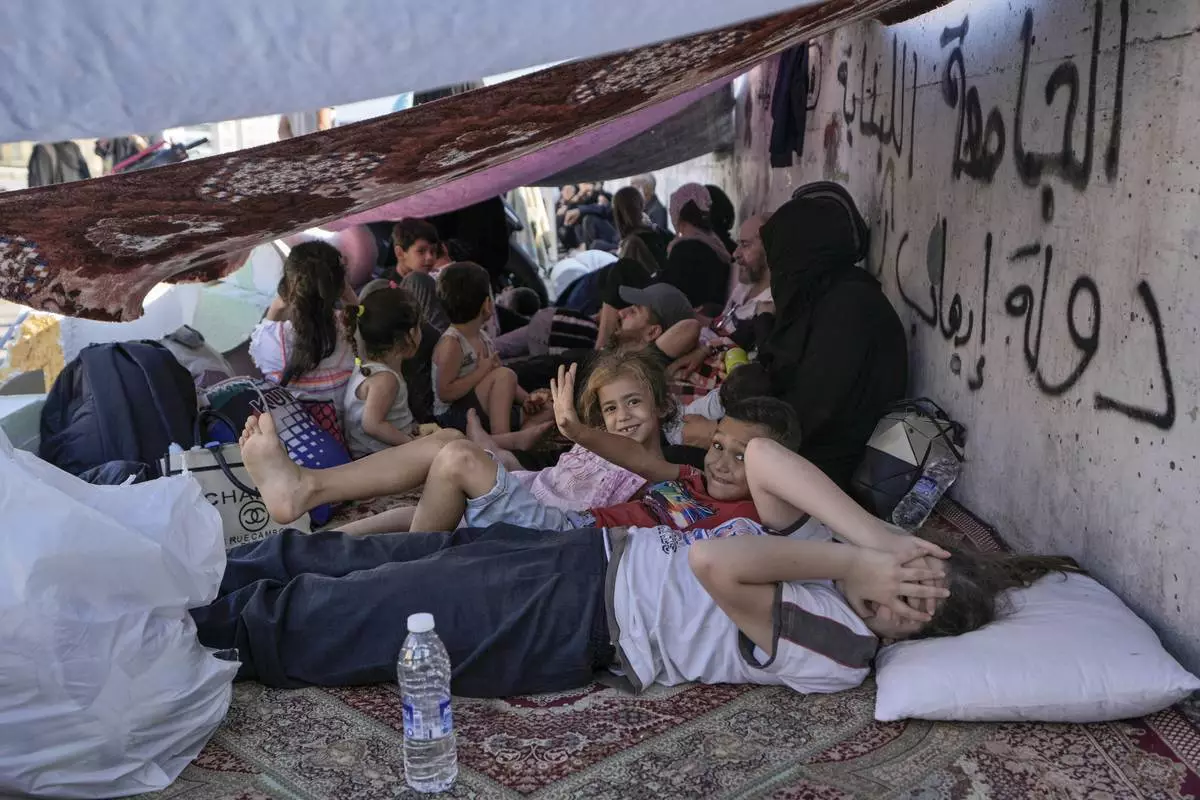
Children with their families lie on the ground in Beirut's Martyrs' square after fleeing the Israeli airstrikes in Beirut's southern suburbs, Saturday, Sept. 28, 2024. (AP Photo/Bilal Hussein)

Smoke rises at the site of Israeli airstrikes in Beirut's southern suburbs, Saturday, Sept. 28, 2024. (AP Photo/Hussein Malla)
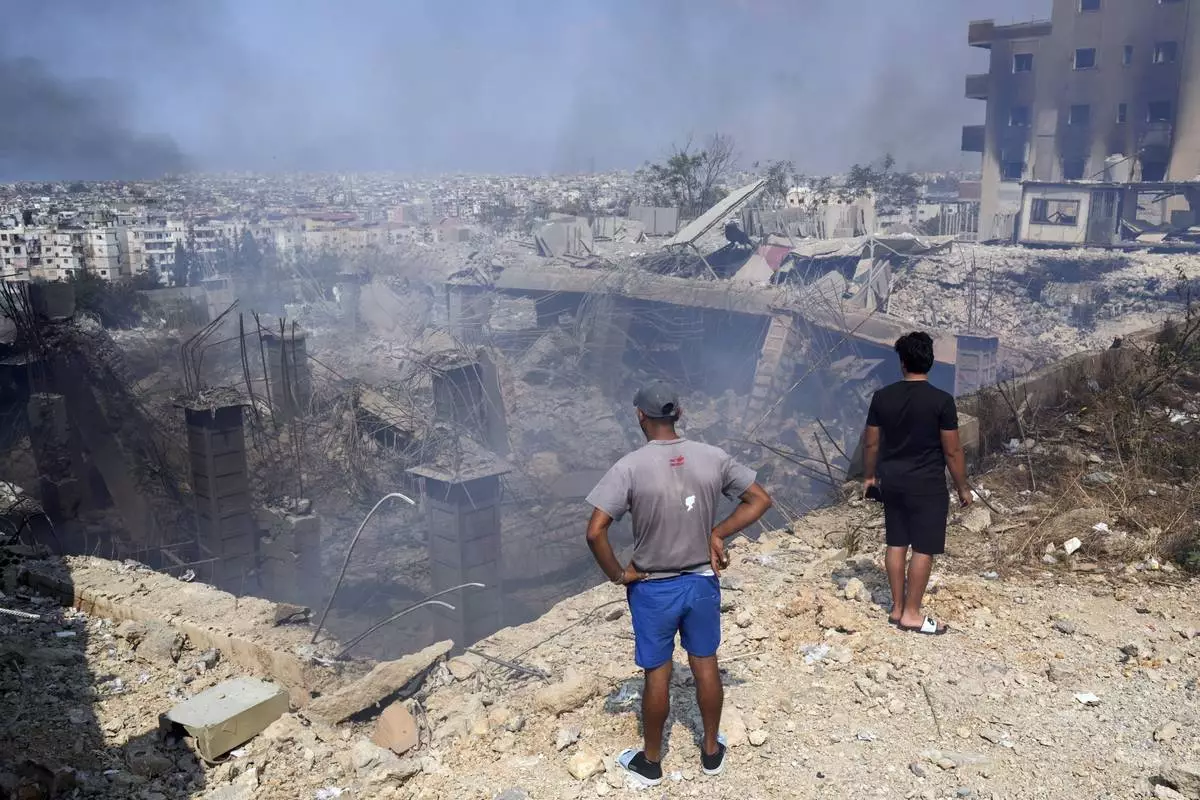
People check a damaged building at the site of an Israeli airstrike in Choueifat, south east of Beirut, Saturday, Sept. 28, 2024. (AP Photo/Hussein Malla)

Smoke rises as a building collapses in Beirut's southern suburbs, Saturday, Sept. 28, 2024. (AP Photo/Hussein Malla)
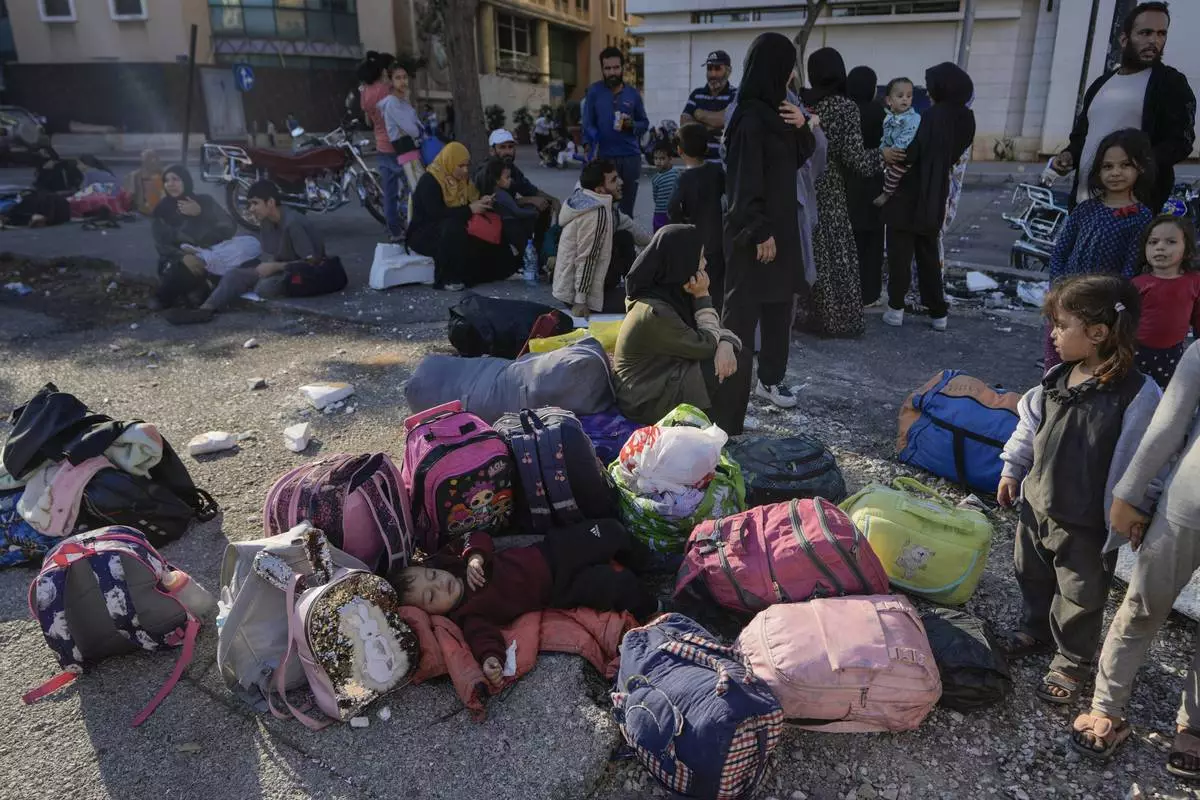
Families gather in Martyrs' square after fleeing the Israeli airstrikes in Beirut's southern suburbs, Saturday, Sept. 28, 2024. (AP Photo/Bilal Hussein)
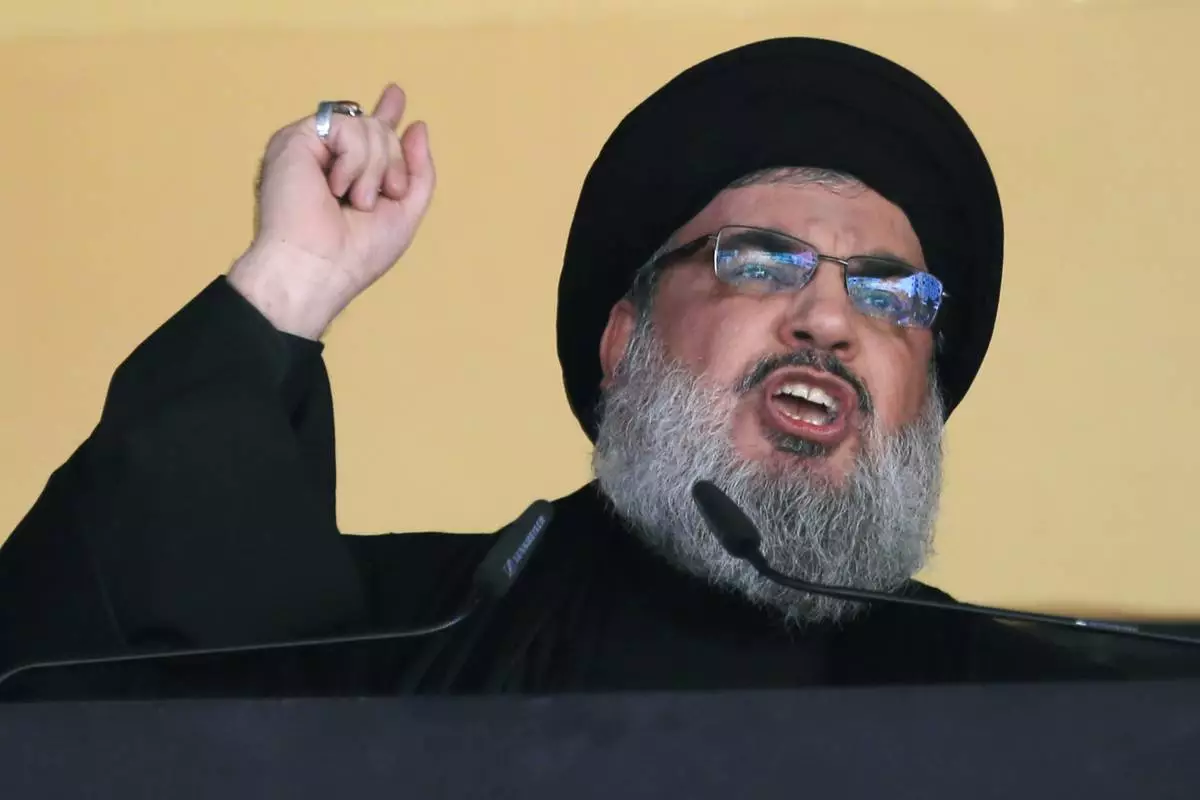
FILE - In this Oct. 24, 2015 file photo, Hezbollah leader Sheik Hassan Nasrallah addresses a crowd during the holy day of Ashoura, in a southern suburb of Beirut, Lebanon. (AP Photo/Hassan Ammar, File)
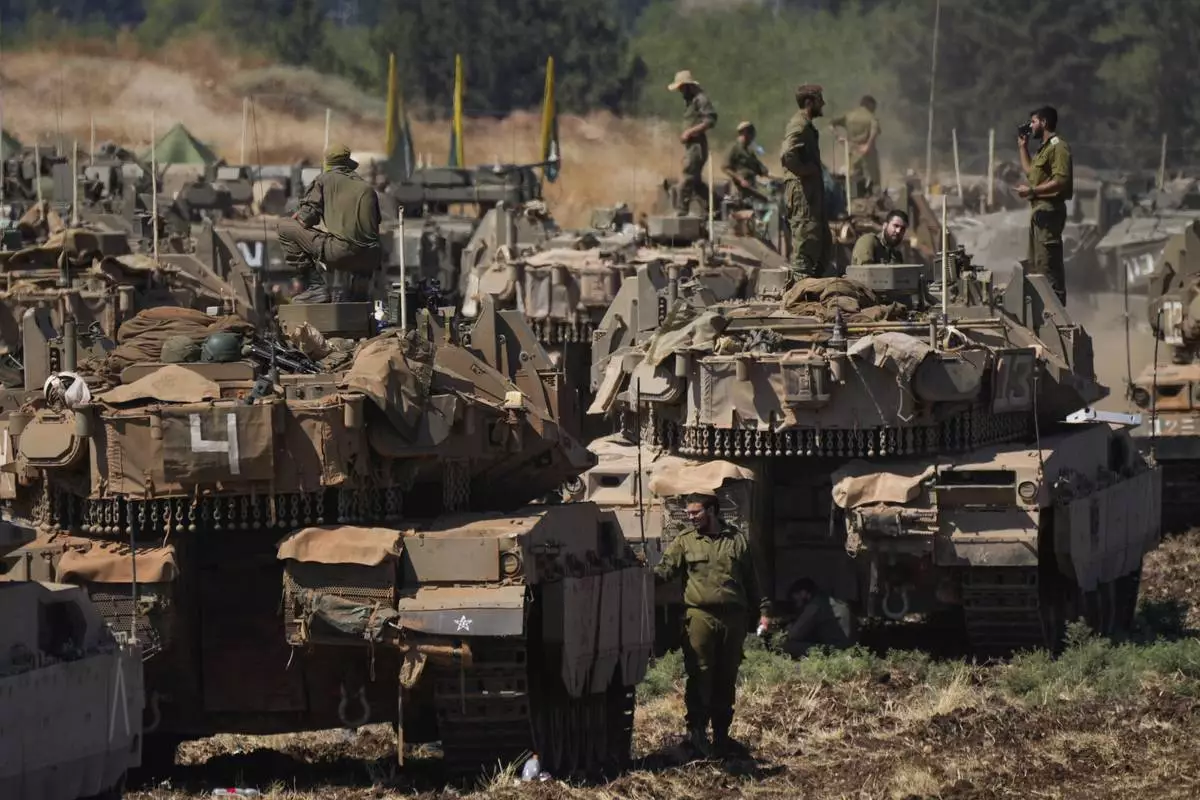
Israeli soldiers work on tanks in northern Israel on Friday, Sept. 27, 2024. (AP Photo/Baz Ratner)
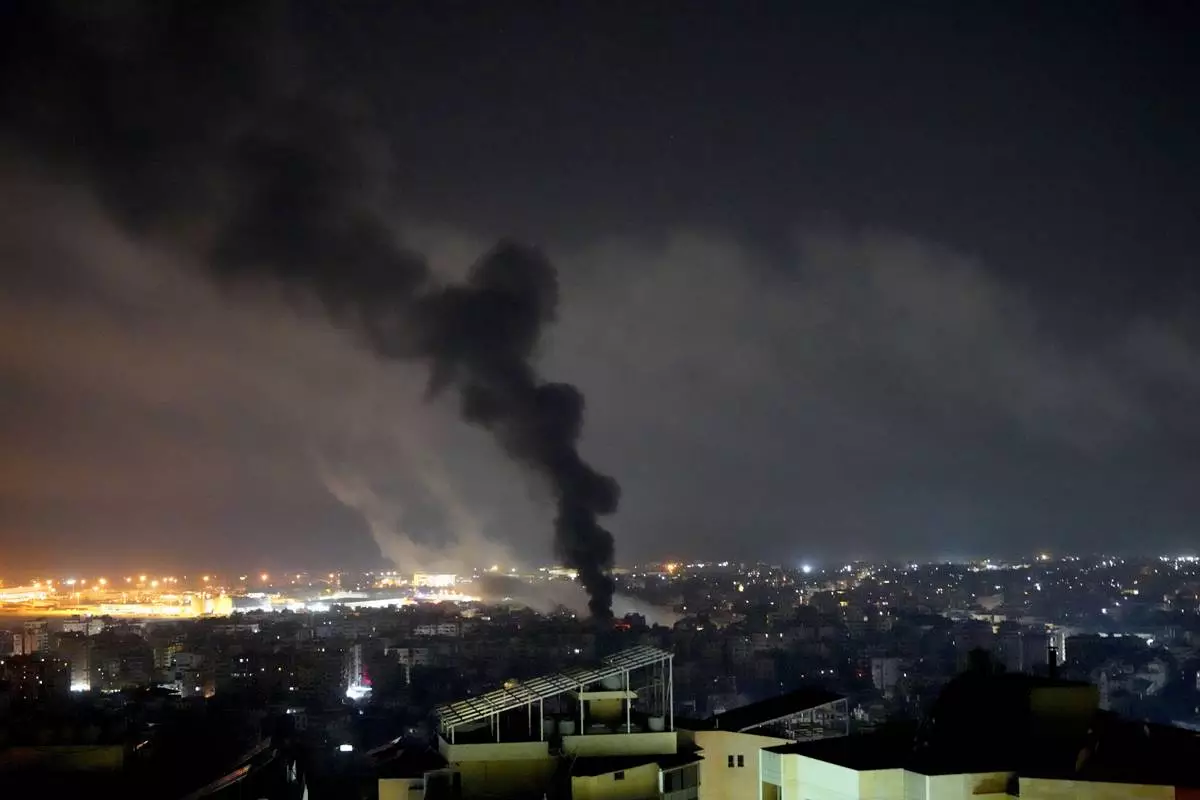
Smoke rises from Israeli airstrikes in Beirut's southern suburbs, Lebanon, Saturday, Sept. 28, 2024. (AP Photo/Hassan Ammar)
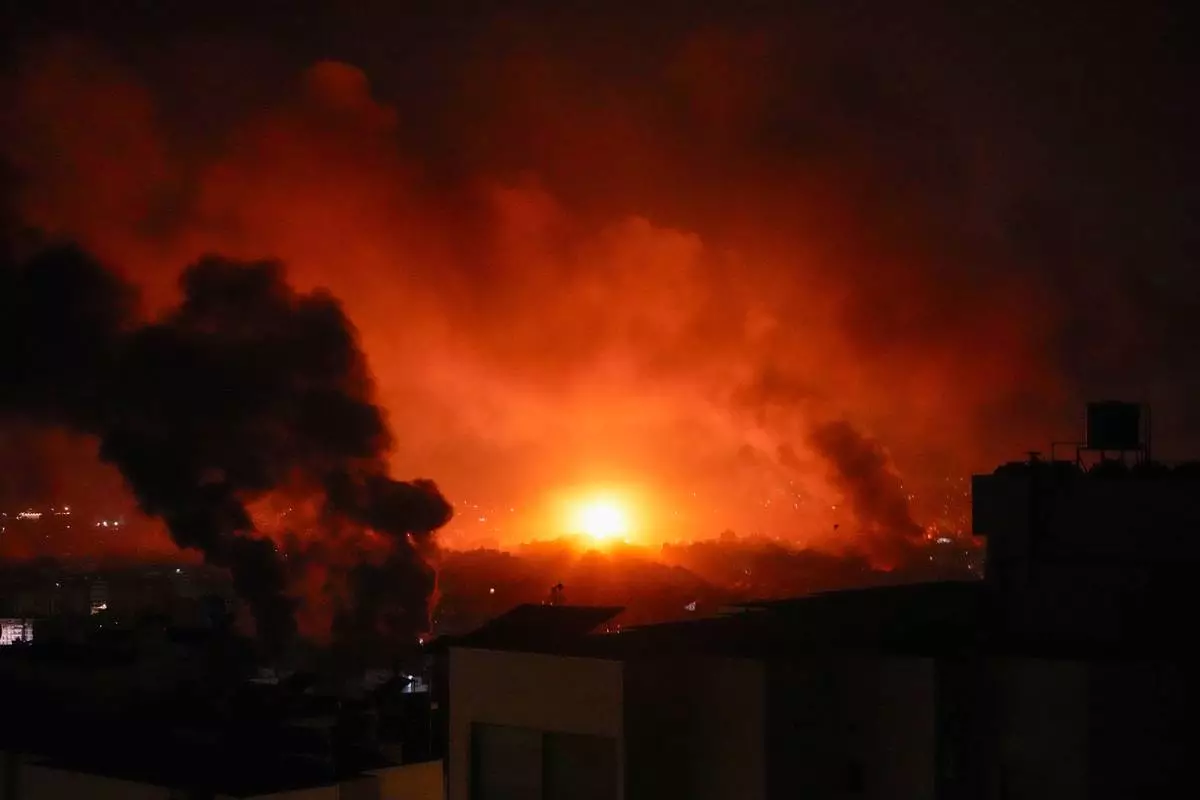
Smoke and fire rise following an Israeli airstrikes in Beirut's southern suburbs, Lebanon, Saturday, Sept. 28, 2024. (AP Photo/Hassan Ammar)

Rescuers arrive near the site of an Israeli airstrike in Beirut's southern suburbs, Friday, Sept. 27, 2024. (AP Photo/Hassan Ammar)
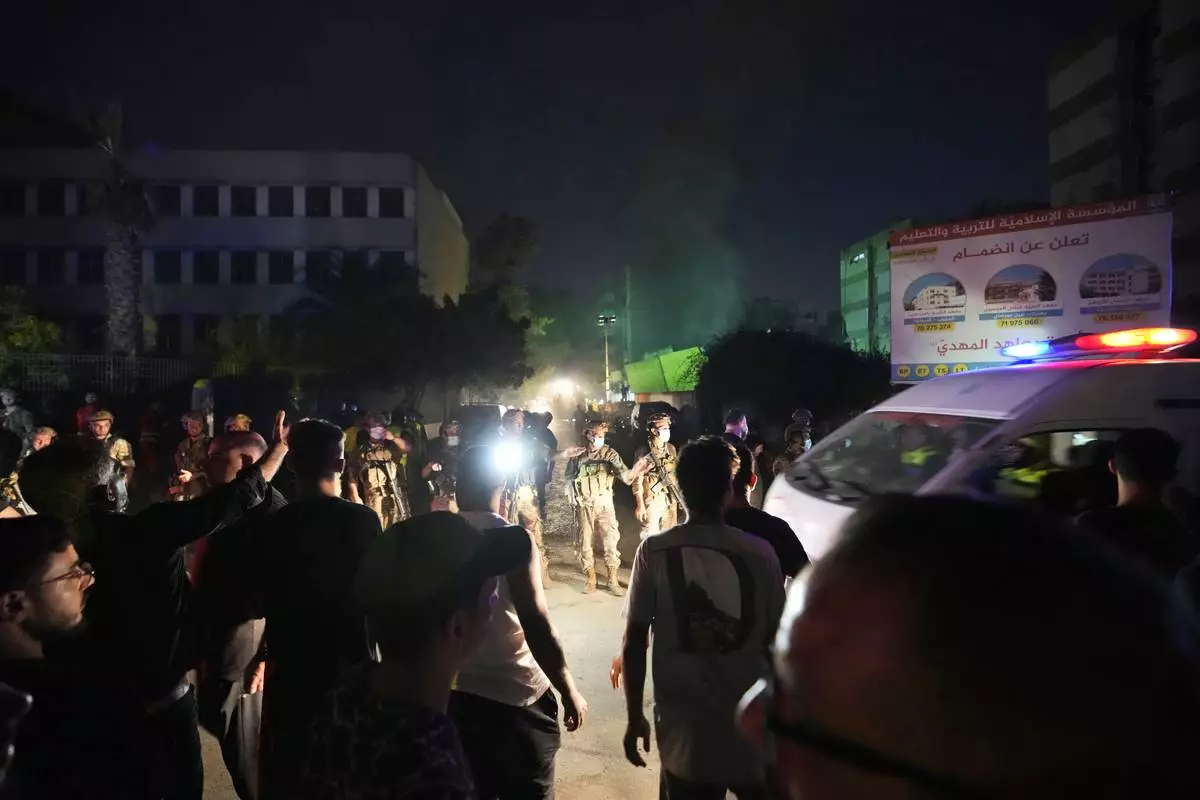
Rescuers arrive near the site of an Israeli airstrike in Beirut's southern suburbs, Friday, Sept. 27, 2024. (AP Photo/Hassan Ammar)

A wounded man sits in an ambulance at the site of an Israeli airstrike in Beirut's southern suburbs, Friday, Sept. 27, 2024. (AP Photo/Hassan Ammar)
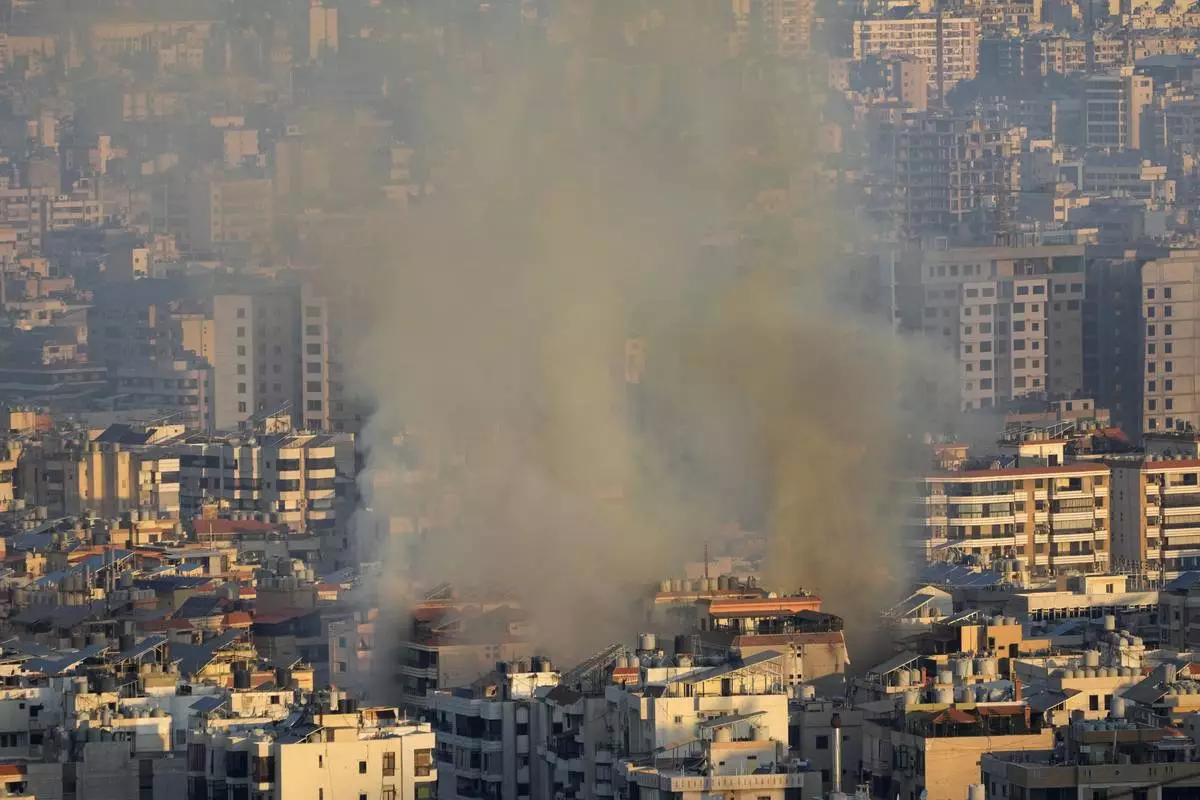
Smoke rises from an Israeli airstrike in the southern suburbs of Beirut, Lebanon, Saturday, Sept. 28, 2024. (AP Photo/Hussein Malla)
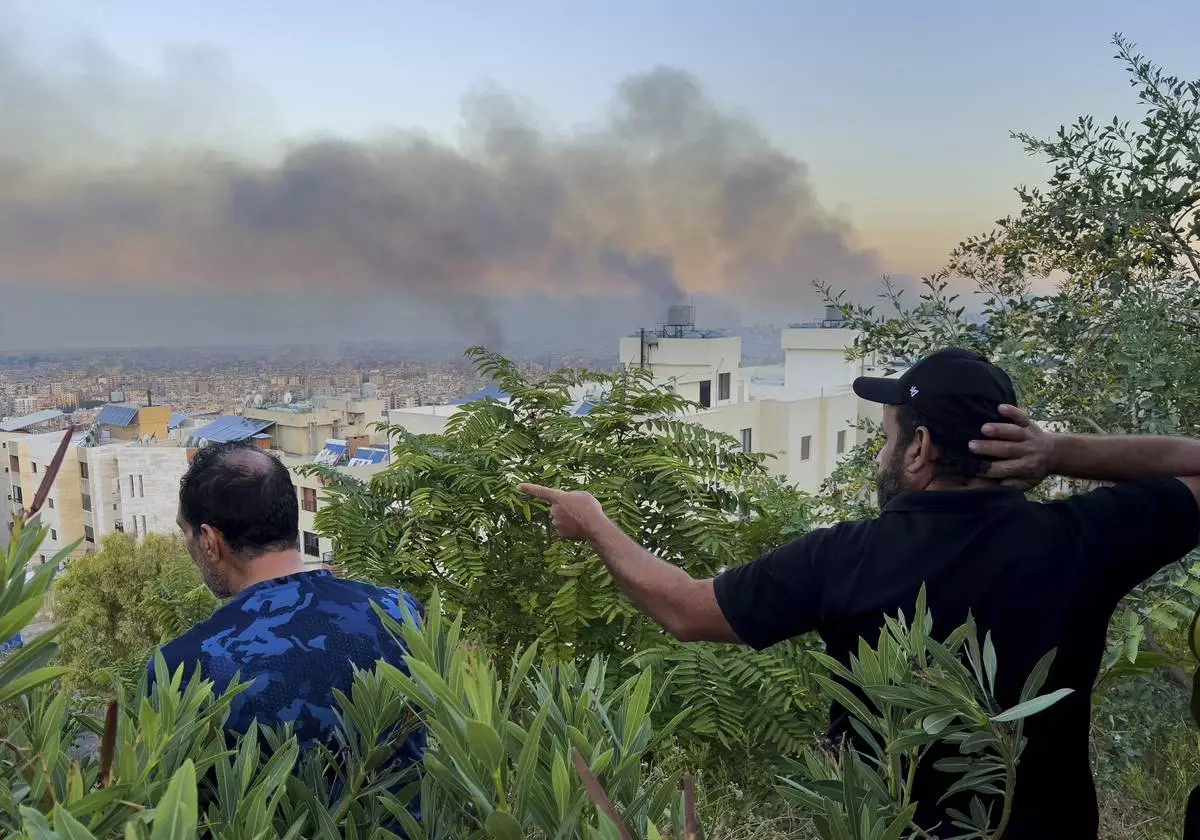
Lebanese citizens watch smoke rise from Israeli airstrikes in the southern suburbs of Beirut, Lebanon, Saturday, Sept. 28, 2024. (AP Photo/Hussein Malla)
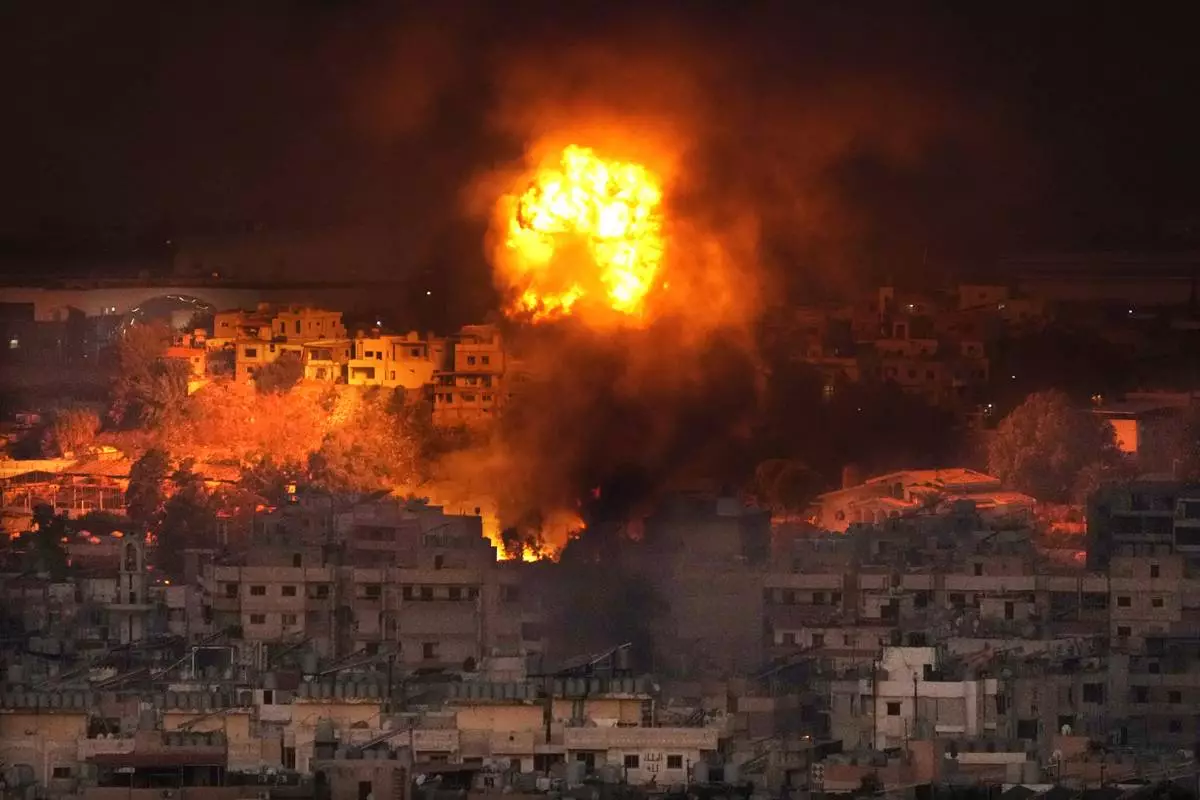
Flames rise after an Israeli airstrike in the southern suburbs of Beirut, Lebanon, Saturday, Sept. 28, 2024. (AP Photo/Hussein Malla)

Rescuers gather as smoke rises from a collapsed building at the site of an Israeli airstrike in Beirut's southern suburbs, Friday, Sept. 27, 2024. (AP Photo/Hassan Ammar)
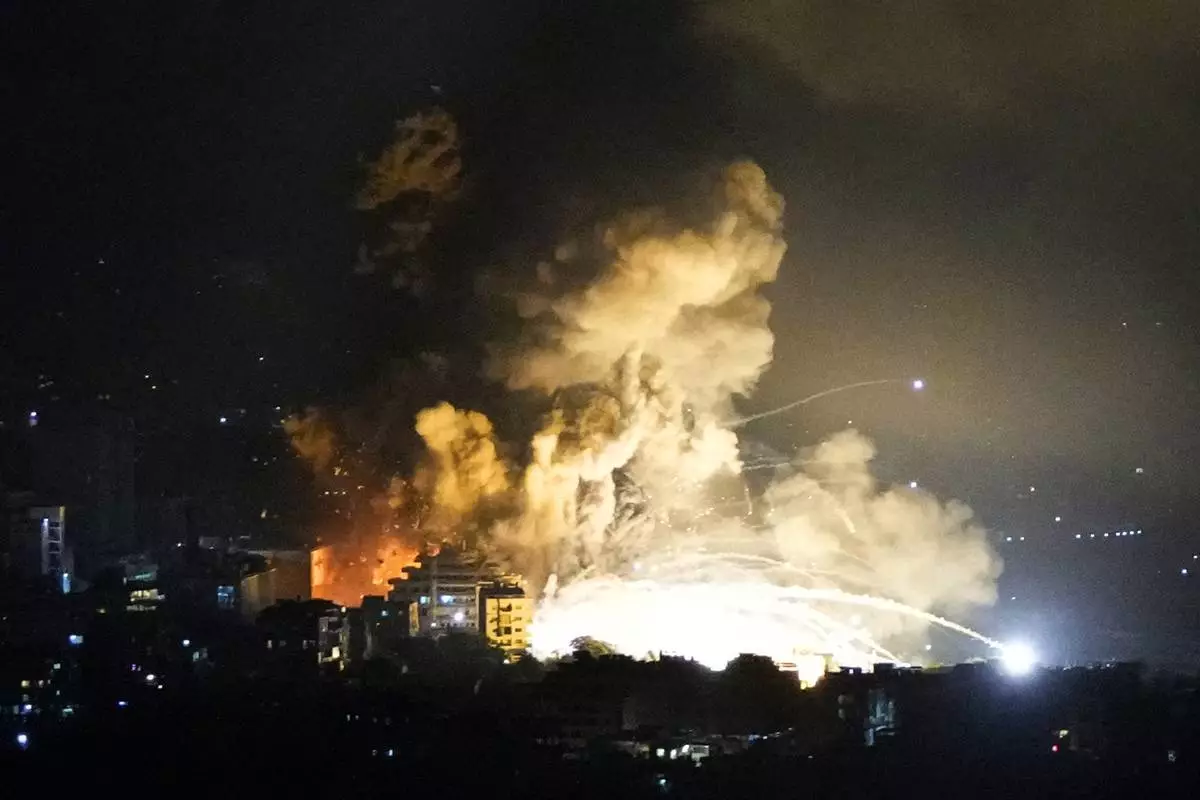
Smoke rises from Israeli airstrikes in Beirut's southern suburbs, Lebanon, Saturday, Sept. 28, 2024. (AP Photo/Hassan Ammar)

An Israeli soldier carries a shell next to a tank in northern Israel on Friday, Sept. 27, 2024. (AP Photo/Baz Ratner)








